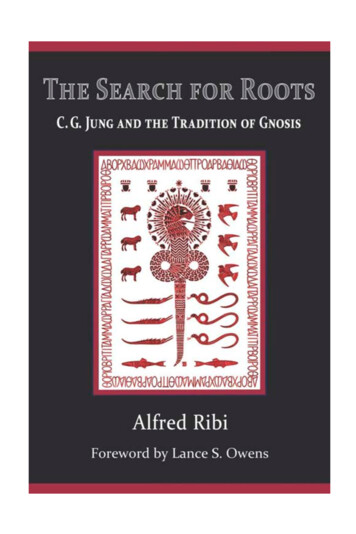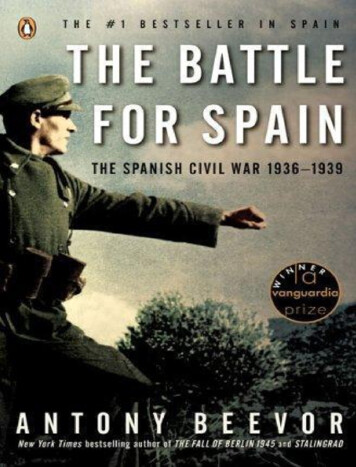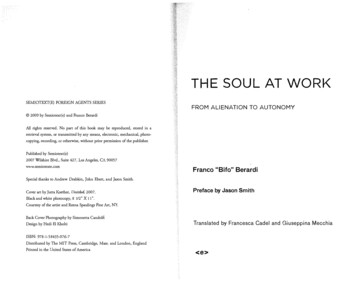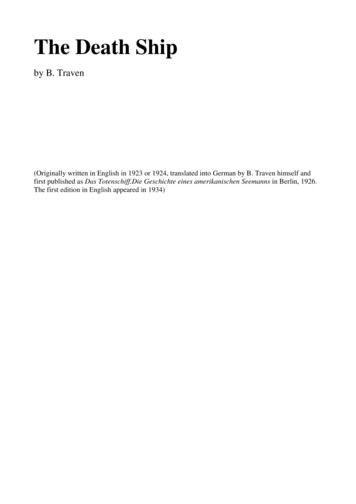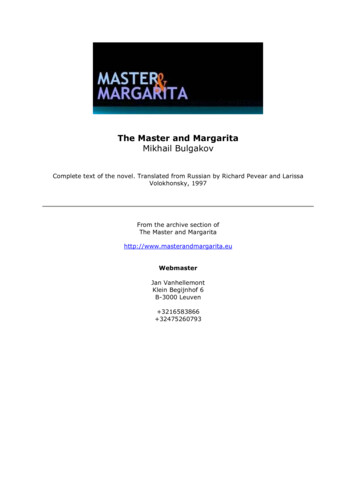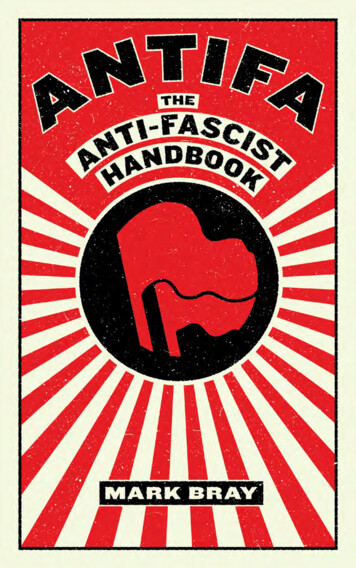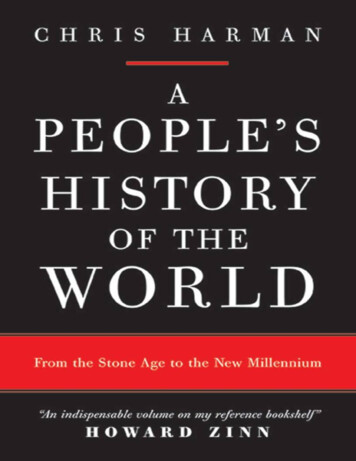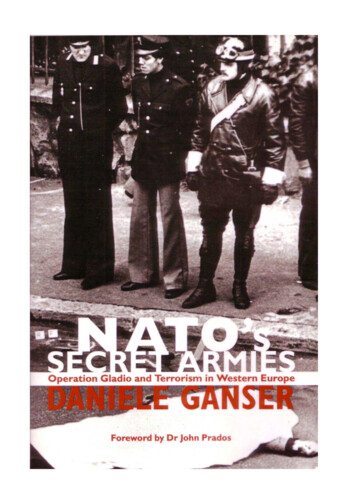
Transcription
Introduction11 A terrorist attack in Italy32 A scandal shocks Western Europe153 The silence of NATO, CIA and MI6254 The secret war in Great Britain385 The secret war in the United States516 The secret war in Italy637 The secret war in France848 The secret war in Spain1039 The secret war in Portugal11410 The secret war in Belgium12511 The secret war in the Netherlands14812 The secret war in Luxemburg165ix
13 The secret war in Denmark16814 The secret war in Norway17615 The secret war in Germany18916 The secret war in Greece21217 The secret war in Turkey224Conclusion245ChronologyNotesSelect bibliographyIndexx250259301303
FOREWORDAt the height of the Cold War there was effectively a front line in Europe. WinstonChurchill once called it the Iron Curtain and said it ran from Szczecin on theBaltic Sea to Trieste on the Adriatic Sea. Both sides deployed military power alongthis line in the expectation of a major combat. The Western European powerscreated the North Atlantic Treaty Organization (NATO) precisely to fight thatexpected war but the strength they could marshal remained limited. The SovietUnion, and after the mid-1950s the Soviet Bloc, consistently had greater numbersof troops, tanks, planes, guns, and other equipment. This is not the place to pullapart analyses of the military balance, to dissect issues of quantitative versusqualitative, or rigid versus flexible tactics. Rather the point is that for many yearsthere was a certain expectation that greater numbers would prevail and the Sovietsmight be capable of taking over all of Europe.Planning for the day the Cold War turned hot, given the expected Soviet threat,necessarily led to thoughts of how to counter a Russian military occupation ofWestern Europe. That immediately suggested comparison with the Second WorldWar, when Resistance movements in many European countries had bedevilledNazi occupiers. In 1939-1945 the anti-Nazi Resistance forces had had to beimprovised. How much the better, reasoned the planners, if the entire enterprisecould be prepared and equipped in advance.The executive agents in the creation of the stay-behind networks werethe Central Intelligence Agency (CIA) of the United States and the SecretIntelligence Service (SIS or MI6) of the United Kingdom. Other major actorsincluded security services in a number of European countries. In all cases identicaltechniques were used. The intelligence services made an effort to establishdistinct networks for spying on the occupiers, that is espionage, and for sabotage,or subverting an enemy occupation. To establish the networks the CIA and othersrecruited individuals willing to participate in these dangerous activities, oftenallowing such initial, or chief, agents to recruit additional sub-agents. Intelligenceservices provided some training, placed caches of arms, ammunition, radioequipment, and other items for their networks, and set up regular channels forcontact. The degree of cooperation in some cases ranged up to the conduct ofexercises with military units or paramilitary forces. The number of recruits for thexi
secret armies ranged from dozens in some nations to hundreds or even thousandsin others.The Resistance example was always an obvious one. Observers of the secretCold War assumed the existence of the networks; so there are occasionalreferences to the stay-behind networks in spy memoirs and literature. But by andlarge the subject was acknowledged with a wink and a nod. Until almost the endof the Cold War. In the summer of 1990, after the collapse of Soviet-dominatedregimes in Eastern Europe, but prior to the final disintegration of the Soviet Union,the Italian government made public the existence of such a network in thatcountry. Over the years since there has been a recurrent stream of revelationsregarding similar networks in many European nations, and in a number of countries there have been official investigations.For the first time in this book, Daniele Ganser has brought together the fullstory of the networks the Italians came to call 'Gladio'. This is a significant anddisturbing history. The notion of the project in the intelligence services undoubtedlybegan as an effort to create forces that would remain quiescent until war broughtthem into play. Instead, in country after country we find the same groups ofindividuals or cells originally activated for the wartime function beginning toexercise their strength in peacetime political processes. Sometimes these effortsinvolved violence, even terrorism, and sometimes the terrorists made use of thevery equipment furnished to them for their Cold War function. Even worse,police and security services in a number of cases chose to protect the perpetratorsof crimes to preserve their Cold War capabilities. These latter actions resulted in theeffective suppression of knowledge of Gladio networks long after their activitiesbecame not merely counterproductive but dangerous.Mining evidence from parliamentary inquiries, investigative accounts,documentary sources, trials, and individuals he has interviewed, Ganser tracksthe revelation of Gladio in many countries and fills in the record of what thesenetworks actually did. Many of their accomplishments were in fact antidemocratic,undermining the very fabric of the societies they were meant to protect. Moreover, bylaying the records in different nations side by side, Ganser's research shows acommon process at work. That is, networks created to be quiescent became activistsin political causes as a rule and not as an exception.Deep as Dr Ganser's research has been, there is a side to the Gladio story hecannot yet reveal. This relates to the purposeful actions of the CIA, MI6 andother intelligence services. Because of the secrecy of government records in theUnited States, for example, it is still not possible to sketch in detail the CIA's ordersto its networks, which could show whether there was a deliberate effort to interferewith political processes in the countries where Gladio networks were active. Therewere real efforts carried out by Gladio agents but their controllers' orders remain inthe shadows, so it is not yet possible to establish the extent of the US role overall in theyears of the Cold War. The same is true of MI6 for Great Britain and for securityservices elsewhere. At a minimum Dr Ganser's record shows that capabilitiescreated for straightforward purposes as part of the Cold War ultimately turned toxii
more sinister ends. Freedom of Information in the United States provides an avenueto open up government documents; but that process is exceedingly slow andsubject to many exemptions, one of which is intended precisely to shield recordson activities of this type. The United Kingdom has a rule that releases documentsafter a certain number of years, but there is a longer interval required fordocuments of this type, and exceptions are permitted to government when documentsare finally released to the public. The information superhighway is barely amacadam path when it comes to throwing light on the truth of the Gladio networks.In this age of global concern with terrorism it is especially upsetting to discoverthat Western Europe and the United States collaborated in creating networks thattook up terrorism. In the United States such nations are called 'state sponsors' and arethe object of hostility and sanction. Can it be the United States itself, Britain,France, Italy, and others who should be on the list of state sponsors? The Gladio storyneeds to be told completely so as to establish the truth in this matter. DanieleGanser has taken the critical first step down this road. This book should be read todiscover the overall contours of Gladio and to begin to appreciate the importance ofthe final answers that are still lacking.John PradosWashington, DCxiii
ACKNOWLEDGEMENTSWhen looking for a PhD research topic in early 1998, I became interested inthe Gladio phenomenon, of which I had not previously heard. After someresearch I realised that despite its great importance for the most recent political,social and military history of Western Europe and the United States, only verylimited work had been carried out on the phenomenon of the secret NATOarmies, with no single study on the topic available in English. As the complexstructure of the network and the mysteries surrounding it increasingly caught myinterest, many well-meaning friends advised me against taking it as a PhD topic.Very sensibly they argued that I would gain access neither to the archives of thesecret services, nor to primary data on the topic from NATO and its Office ofSecurity. Furthermore they predicted that the number of countries, which by theend of my research had unexpectedly risen to fourteen, as well as the time frameI intended to investigate in each of these countries, five decades, not only wouldwear me out, but would also necessarily leave my findings fragmented andincomplete. That in addition to these problems I would have to work with textsin more than ten different European languages, of which I personally couldonly read five, made matters crystal clear: Gladio was not a suitable PhD researchtopic.With great fascination for the phenomenon, a certain degree of youthfulstubbornness, and above all a supportive environment I nevertheless embarked uponthe research project and dedicated the next four years of my life to the investigation.At the time my determination to proceed, and my ability to convince my advisingprofessors, was based on one single original document from the Italian militarysecret service SIFAR, dated June 1, 1959 and entitled 'The special forces of SIFARand Operation Gladio'. This document proved that a CIA- and NATO-linkedsecret army code-named Gladio had existed in Italy during the Cold War, yet furtheroriginal documents were very hard to come by. In retrospect I therefore have toadmit that my well-meaning friends had been right. For among the numerousobstacles that arose during the years of research many were the ones predicted.First of all, the field of research was indeed large, both as to the number ofcountries, and to the time frame. I started with a focus on Italy, where operationxiv
Gladio was exposed in 1990. Based on the Italian sources I quickly realised,however, that the so-called stay-behind armies had existed in all 16 NATO countries during the Cold War. Further research led me to conclude that of the 16NATO countries both Iceland, with no armed forces, and Canada, far removedfrom the Soviet frontier, could be neglected. Yet, while I was somewhat relievedto calculate that this would leave me w i t h the analysis of stay-behind armiesin 14 countries, I found with a certain surprise that secret stay-behind armies withindirect links to NATO had also existed in the four neutral countries, Sweden,Finland, Austria and my native Switzerland, during the Cold War. In this bookI am presenting the data for the NATO countries only. A forthcoming publicationwill deal specifically with the equally sensitive issues of secret NATO-linkedstay-behind armies in the neutral countries.Next to the challenges that arise with respect to the number of countries, gathering data for each single country too proved difficult. It was most distressingthat governments, NATO and secret services withheld requested documentsdespite a FOIA request to the CIA, numerous letters to NATO, and officialrequests to European governments. Next to only a very small number of primarydocuments, the analysis had therefore to be based on numerous secondary sources,including parliamentary reports, testimonies of persons involved as reported bythe international press, articles, books and documentaries, needless to say, suchsecondary sources can never be a substitute for the original primary documents, and all future research must clearly aim for access to primary documents.If, however, the data presented hereafter first of all enables researchers to gain anoverview of a phenomenon which otherwise might have remained inaccessible,and in the second place enables processes which in the future will lead to accessto primary documents, then the main purposes of this book will have beenachieved.That despite the mentioned numerous obstacles, the years of intensive researchhave led to a hopefully valuable international analysis of the stay-behind armiesand the secret war in Western Europe is to a large degree attributable to theinternational professional help and support that I was allowed to enjoy. First ofall I want to thank my two academic advisers for their truly valuable assistance,Professor Georg Kreis of Basel University, and Professor Jussi Hanhimaki of theGraduate Institute of International Studies in Geneva, formerly with the LondonSchool of Economics and Political Science where we met in a most stimulatingenvironment. Their feedback on numerous drafts sharpened my questions whenthey were too vague. Their frank criticism helped me to focus on the secret armieswhen I was drifting away. And their experience in the field of academic researchrestrained my judgement, and opened the way for a balanced understanding.When I presented my Gladio research and passed my final PhD exams in September2001, we all felt that it was a timely book, for in that month, investigations intointernational terrorism had become a high priority on the agenda. During thesubsequent years we have in a very strange way become accustomed to living ina world that suffers from both war and terrorism, and my warm thanks thereforexv
also go to Professor Andreas Wenger, Director of the Center for Security Studiesin Zurich, for his support for future research into Gladio and terrorism here at theinstitute.Furthermore my gratitude goes to Washington-based CIA author WilliamBlum who first drew my attention to Gladio and taught me a lot on covert action andsecret warfare. Very warm thanks also go to Professor Noam Chomsky in Bostonwho not only encouraged my research, but also provided me with valuable contactsduring our meetings in the United States and in Switzerland. In Cambridge,Professor Christopher Andrew supported my research, while in Washington,Professor Christopher Simpson drew my attention to interesting contacts in theUnited States. In Austria, Professor Siegfried Beer provided me with valuabledata and kindly encouraged my research. In London, finally, I copied numerousvaluable documents at the Statewatch institute, where Trevor Hemmings provedto me how excellent work can be done with little money.It must be stated here at the outset of the book that all quotes other than fromEnglish originals are translations by the author, who alone bears responsibilityfor their accuracy. At the same time it goes without saying that the numerouscountries could not have been investigated without the help of my internationalnetwork, which assisted me both in the initial phase of locating and getting holdof the documents, and during subsequent translation hours. In Germany I want tothank journalist and Gladio author Leo Miiller, as well as Erich SchmidtEenboom from the research institute on peace and politics. In the Netherlands,Dr Paul Koedijk and Dr Cees Wiebes, as well as Frans Kluiters, all members ofthe Netherlands Intelligence Studies Association, kindly shared with me valuableGladio material and interesting days in Amsterdam, while academic Micha deRoo assisted me with the Dutch translations. In Denmark, I want to thank ProfessorPaul Villaume of Copenhagen University who shared interesting data with me,and Eva Ellenberger of Basel University who helped me to understand the Danishtexts. In Norway, I want to thank my friend Pal Johansen for our excellent time atthe London School of Economics and Political Science and his professional helpin crucial times when it came to the translation of Norwegian texts. In Austria,journalist Markus Kemmerling and the Zoom political magazine supported myresearch. In Basel, Ali Burhan Kirmizitas helped me greatly with the translationof Turkish texts and provided me with important documents on Gladio in Turkey.Academic Ivo Cunha kindly shared with me data on Gladio in Portugal and inSpain, while my university friends Baptiste Blanch and Francisco Bouzasassisted me with the Portuguese and Spanish translations. My friend and fellowacademic Martin Kamber finally had the energy to plough through an early PhDmanuscript of over a thousand pages, whereupon he wisely let me know that thetext had to be shortened. Thanks to Ruth Eymann I was able to retreat to a bothbeautiful and silent chalet in a remote valley of the Swiss mountains to carry outthat task.After the PhD thesis had been accepted insigni cum laude at the history department of Basel University in Switzerland, Prank Cass and Andrew Humphrys ofXVI
Taylor and Francis, UK, and Kalpalathika Rajan of Integra Software Services,I ndia, helped me greatly to make my research publicly accessible on the globalbook market. Last but not least, complete research independence was guaranteedby the generous financial support of The Swiss National Science Foundation, theJanggen-Pohn Stiftung in St Gallen, the Max Geldner Stiftung in Basel, and theFrewillige Akademische Gesellschaft in Basel. Special thanks go to my mother,my father and my sister, to Sherpa Hanggi, Marcel Schwendener, Tobi Poitmann,Dane Aebischer, Rene Ab Egg, Laurenz Bolliger, Philipp Schweighauser, NikoBally, Yves Pierre Wirz and Andi Langlotz for numerous inspiring and controversial late-night discussions on international politics, global trends and problems,and our personal quest for happiness and meaning in life.Daniele GanserSils Maria, Switzerlandxvii
DIADODPAllied Clandestine CommitteeAvanguardia NazionaleAginter-PressBureau Central de Renseignement et d'ActionBund Deutscher JugendBundesamt fur VerfassungsschutzBureau nnenlandse VeiligheidsdienstCentro Addestramento GuastatoriCellules Communistes CombattantesComite Clandestin Union OccidentaleCentre d'Entrainement des Reserves ParachutistesCentro Superior de Informacion de la DefensaConfederation Generate du TravailCentral Intelligence AgencyCounter Intelligence CorpsCentral Intelligence GroupCoordinator of Strategic InformationCIA Chief of StationClandestine Planning CommitteeDemocrazia Christiana ItalianaDirector of Central IntelligenceCIA Deputy Director of OperationsCIA Deputy Director of PlansDirection Generale des Etudes et RecherchesDirection General De SeguridadDirection Generale de la Securite ExterieureDefence Intelligence AgencyCIA Directorate of OperationsCIA Directorate of PlansXVIII
ion de la Surveillance du TerritoireEuskadi Ta AskatasunaFederal Bureau of InvestigationFronte Democratico PopolareFremde Heere OstForsvarets EfterretningstjenesteFront de la JeunesseField ManualGeheime StaatspolizeiInlichtingendienst BuitenlandInter Services IntelligenceIntelligence en OperationsJoint Chiefs of StaffCommittee of the Security of the StateGreek Communist PartyKommunistische Partei DeutschlandLochos Oreinon KatadromonMinisterium fur Staatssicherheit, short StasiMillietici Hareket PartisiSecurity ServiceSecret Intelligence Service (SIS)Milli Istihbaarat TeskilatiMouvement Republicain PopulaireNorth Atlantic Treaty OrganizationNorwegian Intelligence ServiceNATO Office of SecurityNational Security AgencyNational Security CouncilNationalsozialistische Deutsche Arbeiterpartei, short NaziOrganisation Armee contre le Communisme InternationalOrganisation de 1'Armee SecreteOesterreichischer Wander- Sport- und GeselligkeitsvereinOrganisation GehlenOzel Harp DairesiOzel Kuvvetler KomutanligiOrganizzazione Mondial del Pensiero e dell' Assistenza MassonicaOrdine NuovoCIA Office of Policy CoordinationOffice of Special ProjectsOffice of Strategic ServicesProjekt 26Projekt 27Propaganda DueParti Communiste Francais
STDTMBBUNAUNOVALPOWACLWNPPartito Communisto ItalianoPolicia Internacional e de Defesa do EstadoParlamentarische KontrollkommissionPartito Socialisto ItalianoRote Armee FraktionRocamboleRassemblement du Peuple FrancaisStay-behindService d'Action CiviqueSupreme Allied Commander EuropeSezione Addestramento GuastatoriSpecial Air ServiceSectie Allgemene ZakenService de Documentation Exterieure et de Contre EspionnageService De Renseignements et d'ActionServicio Central de Documentacion de la DefensaServicio Informacion NavalService General de RenseignementSupreme Headquarters Allied Powers EuropeServizio Informazioni DifesaServizio di Informazioni delle Forze AnnateSecret Intelligence Service (MI6)Servizio Informazioni Sicurezza DemocraticaServizio Informazioni Sicurezza MilitareSpecial Operations ExecutiveSozialdemokratische Partei DeutschlandSpecial Procedures GroupSchutzstaffelTechnischer DienstTripartite Meeting Belgian/BrusselsUntergruppe Nachrichtendienst und AbwehrUnited Nations OrganisationValtion PoliisiWorld Anticommunist LeagueWestland New Postxx
INTRODUCTIONAs the Cold War ended, following juridical investigations into mysteriousacts of terrorism in Italy, Italian Prime Minister Giulio Andreotti was forcedto confirm in August 1990 that a secret army existed in Italy and other countriesacross Western Europe that were part of the North Atlantic Treaty Organization(NATO). Coordinated by the unorthodox warfare section of NATO, the secretarmy had been set up by the US secret service Central Intelligence Agency (CIA)and the British Secret Intelligence Service (MI6 or SIS) after the end of theSecond World War to fight Communism in Western Europe. The clandestinenetwork, which after the revelations of the Italian Prime Minister was researchedby judges, parliamentarians, academics and investigative journalists acrossEurope, is now understood to have been code-named 'Gladio' (the sword) in Italy,while in other countries the network operated under different names including'Absalon' in Denmark, 'ROC' in Norway and 'SDRA8' in Belgium. In each countrythe military secret service operated the anti-Communist army within the state in closecollaboration with the CIA or the MI6 unknown to parliaments and populations.In each country, leading members of the executive, including Prime Ministers,Presidents, Interior Ministers and Defence Ministers, were involved in theconspiracy, while the 'Allied Clandestine Committee' (ACC), sometimes alsoeuphemistically called the 'Allied Co-ordination Committee' and the 'ClandestinePlanning Committee' (CPC), less conspicuously at times also called 'Coordinationand Planning Committee' of NATO's Supreme Headquarters Allied Powers Europe(SHAPE), coordinated the networks on the international level. The last confirmedsecret meeting of ACC with representatives of European secret services tookplace on October 24, 1990 in Brussels.As the details of the operation emerged, the press concluded that the 'storyseems straight from the pages of a political thriller'.1 The secret armies wereequipped by the CIA and the MI6 with machine guns, explosives, munitions andhigh-tech communication equipment hidden in arms caches in forests, meadowsand underground bunkers across Western Europe. Leading officers of the secretnetwork trained together with the US Green Berets Special Forces in the UnitedStates of America and the British SAS Special Forces in England. Recruitedamong strictly anti-Communist segments of the society the secret Gladio soldiers1
included moderate conservatives as well as right-wing extremists such as notoriousright-wing terrorists Stefano delle Chiale and Yves Guerain Serac. In its strategicdesign the secret army was a direct copy of the British Special Operations Executive(SOE), which during the Second World War had pararachuted into enemy-heldterritory and fought a secret war behind enemy lines.In case of a Soviet invasion of Western Europe the secret Gladio soldiers underNATO command would have formed a so-called stay-behind network operatingbehind enemy lines, strengthening and setting up local resistance movements inenemy-held territory, evacuating shot-down pilots and sabotaging the supply linesand production centres of the occupation forces with explosives. Yet theSoviet invasion never came. The real and present danger in the eyes of the secretwar strategists in Washington and London were the at-times numerically strongCommunist parties in the democracies of Western Europe. Hence the network inthe total absence of a Soviet invasion took up arms in numerous countries andfought a secret war against the political forces of the left. The secret armies, as thesecondary sources now available suggest, were involved in a whole series of terroristoperations and human rights violations that they wrongly blamed on the Communistsin order to discredit the left at the polls. The operations always aimed at spreadingmaximum fear among the population and ranged from bomb massacres in trainsand market squares (Italy), the use of systematic torture of opponents of theregime (Turkey), the support for right-wing coup d'etats (Greece and Turkey), tothe smashing of opposition groups (Portugal and Spain). As the secret armies werediscovered, NATO as well as the governments of the United States and GreatBritain refused to take a stand on what by then was alleged by the press to be 'thebest-kept, and most damaging, political-military secret since World War II'.22
1A TERRORIST ATTACK IN ITALYIn a forest near the Italian village Peteano a car bomb exploded on May 31, 1972.The bomb gravely wounded one and killed three members of the Carabinieri,Italy's paramilitary police force. The Carabinieri had been lured to the spot by ananonymous phone call. Inspecting the abandoned Fiat 500, one of the Carabinieri hadopened the hood of the car that triggered the bomb. An anonymous call to thepolice two days later implicated the Red Brigades, a Communist terrorist groupattempting to change the balance of power in Italy at the time through hostagetakings and cold-blooded assassinations of exponents of the state. The policeimmediately cracked down on the Italian left and rounded up some 200 Communists.For more than a decade the Italian population believed that the Red Brigades hadcommitted the Peteano terrorist attack.Then, in 1984, young Italian Judge Felice Casson reopened the long dormant caseafter having discovered with surprise an entire series of blunders and fabricationssurrounding the Peteano atrocity. Judge Casson found that there had been nopolice investigation on the scene. He also discovered that the report which at thetime claimed that the explosive used in Peteano had been the one traditionallyused by the Red Brigades was a forgery. Marco Morin, an expert for explosivesof the Italian police, had deliberately provided fake expertise. He was a member ofthe Italian right-wing organisation 'Ordine Nuovo' and within the Cold Warcontext contributed his part to what he thought was a legitimate way of combatingthe influence of the Italian Communists. Judge Casson was able to prove that theexplosive used in Peteano contrary to Morin's expertise was C4, the most powerfulexplosive available at the time, used also by NATO. 'I wanted that new lightshould be shed on these years of lies and mysteries, that's all', Casson years latertold journalists in his tiny office in an eighteenth-century courthouse on the banksof Venice's lagoon. 'I wanted that Italy should for once know the truth.'1On February 24, 1972, a group of Carabinieri had by chance discovered anunderground arms cache near Trieste containing arms, munitions and C4 explosiveidentical to the one used in Peteano. The Carabinieri believed that they hadunveiled the arsenal of a criminal network. Years later, the investigation of JudgeCasson was able to reconstruct that they had stumbled across one of more thanhundred underground arsenals of the NATO-linked stay-behind secret army that3
in Italy was code-named Gladio, the sword. Casso found that the Italian mililarysecret service and the government at the time had gone to great lengths in order tokeep the Trieste discovery and above all its larger strategic context a secret.As Casson continued to investigate the mysterious cases of Peteano and Trieste,he discovered with surprise that not the Italian left but Italian right-wing groups andthe military secret service had been involved in the Peteano terror. Casson'sinvestigation revealed that the right-wing organisation Ordine Nuovo hadcollaborated very closely with the Italian Military Secret Service, SID (ServizioInformazioni Difesa). Together they had engineered the Peteano terror and thenwrongly blamed the militant extreme Italian left, the Red Brigades. Judge Cassonidentified Ordine Nuovo member Vincenzo Vinciguerra as the man who hadplanted the Peteano bomb. Being the last man in a long chain of command,Vinciguerra was arrested years after the crime. He confessed and testified that hehad been covered by an entire network of sympathisers in Italy and abroad whohad ensured that after the attack he could escape. 'A whole mechanism came intoaction', Vinciguerra recalled, 'that is, the Carabinieri, the Minister of the Interior, thecustoms services and the military and civilian intelligence services acceptedthe ideological reasoning behind the attack'.2Vinciguerra was right to point out that the Peteano terror had occurred during aparticularly agitated historical period. With the beginning of the flower powerrevolution, the mass student protests against violence in general and the war inVietnam in particular, the ideological battle between the politica
4 The secret war in Great Britain 38 5 The secret war in the United States 51 6 The secret war in Italy 63 7 The secret war in France 84 8 The secret war in Spain 103 . Both sides deployed military power along this line in the expectation of a major combat. The Western European powers created the North Atlantic Treaty Organization (NATO .
